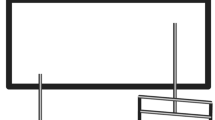Abstract
The present study addressed whether the timing of muscle activation and the relative direction of limb movements are dissociable constraints that may affect learning and transfer of bimanual coordination patterns, either independently or in combination. Subjects were assigned to two experimental groups in which the to-be-learned muscular phasing (135°) was either practiced with 45° (i.e., predominantly isodirectional) or 135° (i.e., predominantly nonisodirectional) of spatial relative phase (RP) across 2 days of practice. Prior to, during, and following practice, probe tests were held in which various relative phasing patterns were administered to assess transfer of learning. Converging evidence was obtained that the relative direction of moving limbs prominently constrained transfer of learning rather than muscular relationships. Acquisition of a specific pattern resulted in spontaneous positive transfer of learning to a new coordination pattern having the same spatial RP but not to a pattern with a different spatial RP, irrespective of muscular phasing relationships. In summary, the present results suggest that learning and transfer of coordination patterns is mediated by abstract directional codes that become part of the memory representation for bimanual coordination.





Similar content being viewed by others
References
Adams JA (1987) Historical review and appraisal of research on the learning, retention and transfer of human motor skills. Psych Bull 101:41–74
Bingham GP, Zaal FTJM, Shull JA, Collins DR (2001) The effect of frequency on the visual perception of relative phase and variability of two oscillating objects. Exp Brain Res 136:543–552
Bogaerts H, Buekers MJ, Zaal FT, Swinnen SP (2003) When visuo-motor incongruence aids motor performance: the effect of perceiving motion structures during transformed visual feedback on bimanual coordination. Behav Brain Res 138:45–57
Bruce V, Green PR (1985) Visual perception. Physiology, psychology and ecology. LEA, London
Debaere F, Wenderoth N, Sunaert S, Van Hecke P, Swinnen S (2003) Internal versus external genration of movements: differential neural pathways involved in bimanual coordination performed in the presence or absence of augmented visual feedback. Neuroimage 19:764–776
Fontaine RJ, Lee TD, Swinnen SP (1997) Learning a new bimanual coordination pattern: reciprocal influences of intrinsic and to-be-learned patterns. Can J Exp Psych 51:1–9
Georgopoulos AP (1995) Current issues in directional motor control. Trends Neurosci 18:506–510
Johansson G (1973) Visual perception in biological motion and a model for its analysis. Percept Psych 14:201–211
Kakei S, Hoffman DS, Strick PL (1999) Muscle and movement representations in the primary motor cortex. Science 285:2136–2139
Kelso JAS (1984) Phase transitions and critical behavior in human bimanual coordination. Am J Phys: Reg Integ Comp 15: R1000–R1004
Kelso JAS (1995) Dynamic patterns: the self-organization of brain and behavior. MIT Press, Cambridge, MA
Kelso JAS, Zanone PG (2002) Coordination dynamics of learning and transfer across different effector systems. J Exp Psych Hum Percept Perform 28:776–797
Kelso JAS, Scholz JP, Schöner G (1986) Non-equilibrium phase transitions in coordinated biological motion: Critical fluctuations. Phys Lett A 134:8–12
Lee TD, Swinnen SP, Verschueren S (1995) Relative phase alterations during bimanual skill acquisition. J Mot Behav 27:263–274
Newell KM (1991) Motor skill acquisition. Ann Rev Psych 42:213–237
Schmidt RA, Lee T (1998) Motor control and learning: a behavioral emphasis. Champaign IL: Human Kinetics
Schmidt RC, Treffner PJ, Shaw BK, Turvey MT (1992) Dynamical aspects of learning an interlimb rhythmic movement pattern. J Mot Behav 21:122–144
Schöner G, Kelso JAS (1988) Dynamic pattern generation in behavioral and neural systems. Science 239:1513–1520
Swinnen SP (2002) Intermanual coordination: from behavioural principles to neural-network interactions. Nat Rev Neurosci 3:350–361
Swinnen SP, Walter CB, Lee TD, Serrien DJ (1993) Acquiring bimanual skills: contrasting forms of information feedback for interlimb decoupling. J Exp Psych Learn Mem Cogn 19:1328–1344
Swinnen SP, Dounskaia N, Walter CB, Serrien D (1997a) Preferred and induced coordination modes during the acquisition of bimanual movements with a 2:1 frequency ratio. J Exp Psych Hum Percept Perform 23:1087–1110
Swinnen SP, Jardin K, Meulenbroek R, Dounskaia N, Hofkens Van den Brandt M (1997b) Egocentric and allocentric constraints in the expression of pattern of interlimb coordination. J Cog Neurosci 9:348–377
Swinnen SP, Jardin K, Verschueren S, Meulenbroek R, Franz L, Dounskia N, Walter CB (1998) Exploring interlimb constraints during bimanual graphic performance: Effects of muscle grouping and direction. Behav Brain Res 90:79–87
Temprado JJ, Swinnen SP, Carson RG, Tourment AL, Laurent M (2003) Interaction of directional, neuromuscular, and egocentric constraints on the stability of preferred bimanual coordination patterns. Hum Mov Sci 22:339–363
Zaal FTJM, Bingham GP, Schmidt RC (2000) Visual perception of mean relative phase and phase variability. J Exp Psych Hum Percept Perform 26:1209–1220
Zanone PG, Kelso JAS (1992) Evolution of behavioral attractors with learning: nonequilibrium phase transitions. J Exp Psych Hum Percept Perform 18:403–421
Zanone PG, Kelso JAS (1997) Coordination dynamics of learning and transfer: collective and component levels. J Exp Psych Hum Percept Perform 23:1454–1480
Author information
Authors and Affiliations
Corresponding author
Rights and permissions
About this article
Cite this article
Temprado, J.J., Swinnen, S.P. Dynamics of learning and transfer of muscular and spatial relative phase in bimanual coordination: evidence for abstract directional codes. Exp Brain Res 160, 180–188 (2005). https://doi.org/10.1007/s00221-004-1998-7
Received:
Accepted:
Published:
Issue Date:
DOI: https://doi.org/10.1007/s00221-004-1998-7




